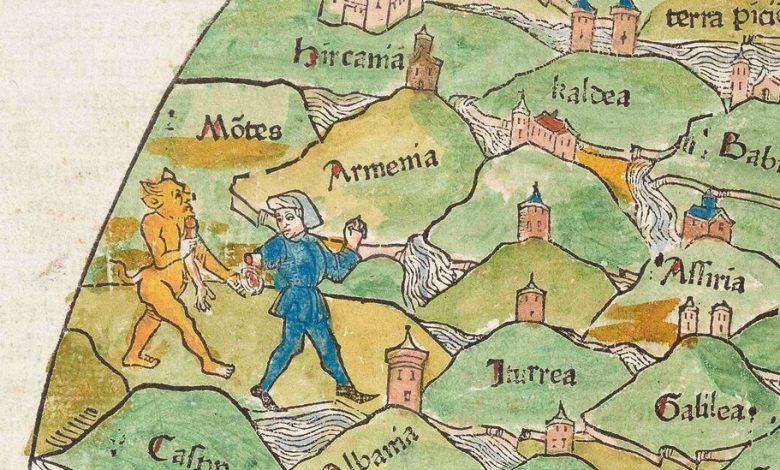Maps That Tell Their Own Stories

Centuries before global positioning systems and computer-aided design software, cartographers were drawing maps to reflect what they considered to be reality on the ground, in the seas and in the skies.
Many of these early efforts have disappeared, and others form parts of major collections like that of the Library of Congress in Washington, D.C., and the British Library in London. Still others are in the hands of private collectors, out of reach for those who wish to study them.
But in the case of the multimillion-dollar Sunderland Collection, the majority of its 130 maps, atlases, globes and more came online last month as Oculi Mundi (the Eyes of the World). The collection was begun more than 30 years ago by the British-born businessman Neil Sunderland, now 78. The online project has been overseen by his daughter Helen Sunderland-Cohen, 48, a lawyer. (Oculi Mundi is not the first map collection to be digitized. For example, the American collector David Rumsey began the digitization of more than 120,000 of his maps in 1996 and he donated his extensive collection to Stanford University.)
While Ms. Sunderland-Cohen would not disclose the cost of creating the Oculi Mundi site, she said it was borne by Adinvest, a Swiss investment firm acquired by Neil Sunderland in the 1980s.
Mr. Sunderland’s fascination with maps began at a young age. “His uncle had a map of Lancashire [England] and he could see all the little towns and villages,” Ms. Sunderland-Cohen said. “When he was a little older, he was in the Boy Scouts. They used to go with their compasses and do activities, and then he started traveling when he was a student to more remote places like Ethiopia, and overland from Europe all the way to India in the 1960s.
“He has always had this sort of spirit of finding out what the rest of the world is like, and what people think. And I think maps are just such an amazing expression of that.”
The plan now, she said, is to keep the collection intact, but to share it with a wider audience.
“There is an incredibly broad range of people around the world who are interested in maps because they’re such extraordinary objects,” she said. “Some people just like to admire them. And they trigger all sorts of imaginative stories, like ‘Treasure Island’ or the map at the beginning of ‘The Lord of the Rings.’”
“Other people just like to look at their hometown 500 years ago, and see if it was there,” she said. “Still others are completely fascinated by how old maps are and what people were capable of, the skill that people had back then with engraving and color and how the pigments have lasted. And then there are actual map experts, who look at where they sit in the history of European cartography, and what you can tell from different versions of atlases, and the very nitty-gritty scholarship side.”
‘A Proper Nerd’
Daniel Crouch, 49, is a London dealer in antique and vintage maps, atlases and sea charts dating from the 15th to the 19th centuries who has helped the Sunderlands acquire some of its maps. (His business has the distinction of handling the $10 million sale of what he called the “most expensive map ever sold” on the open market: “It’s hanging in the Louvre Abu Dhabi now, a map of the world from 1531.”)
Describing himself “as a proper nerd,” he explained the allure of maps: “Human beings have always been very interested in their location on Earth and their time. The observations of space and place. Maps and calendars and star charts are the mechanisms that we developed to understand both.”
Maps, he said, tell a number of stories: “It can be the story of the map itself: ‘This is the first map to depict New York,’ or ‘This is the first printed star chart.’ It can also be about the mapmaker. Is it the work of Albrecht Dürer, Leonardo da Vinci or Hans Holbein the Younger?”
“But also it could be just about the artistic quality and the beauty or sometimes even just its size,” he said.
Or how it was made.
“One of the earlier atlases we have,” Mrs. Sunderland-Cohen said, “by Francesco Berlinghieri in 1482, is one of the earliest uses of copper plate, in atlases and in print. You can see how finely engraved the lines are, and how they’re learning to use copper plate.”
“These atlases would take ages to make,” she said. “You would have people carving wood plates, or copper plates, then you would have someone printing, then they would be hand-colored. A number of our objects also are particularly high color, which means that they also have little gold embellishments.
“When you look back and think of when this was all being done, and the type of tools that they had available, and the lengths they had to go to to get certain colors and pigments and all the cartographical and scientific knowledge on top of that: It’s really amazing.”
A Favorite
Among the Oculi Mundi highlights are maps in which Dürer or Holbein had a hand. Also, a heart-shaped map of the world from 1566 by the Italian artist Giovanni Cimerlino; and a colorful world map from 1578 by the Belgian cartographer Cornelis de Jode.
One of her favorite maps, she said, is in the “Rudimentum Novitiorum,” an illustrated chronicle in Latin used by monks as a teaching aid for novices. Published by Lucas Brandis de Schass of Lübeck, Germany, in 1475, the atlas’s author and its cartographer remain anonymous.
“It tells biblical history that is illustrated with lots of wonderful woodblock drawings, and everybody’s wearing clothing of the day, and in the houses of the day,” she said. “This is a really good example of the transition from handwritten manuscripts to print. Some of the pages still have very decorated capital letters, like you would find in an illuminated manuscript, but it’s a printed book and you can see them kind of dealing with his new technology and experimenting.
“It’s almost like they can’t help themselves: They see a capital letter, and it’s like, oh, let me embellish that. But I particularly find this fascinating because it gives you a lens into 15th-century life.”
But another London dealer in rare books and maps, Bernard Shapero, 60, considers early cartographers more like scientists than artists or artisans.
“They were measuring land. And drawing out maps,” he said. “Pretty much from the 16th century onward, mapmaking was more of a scientific role than a craftsman role. Of course there were some people who did the more decorative types, but most of the great cartographers were sort of scientists, mathematicians.”
Buyers today, he said, tend to “collect maps of areas they either live in or know and love. Like a beautiful map of New York: you can enjoy looking at it and going, ‘Oh, look at that. That’s now my local deli but in 1850, it was a theater.’” At his shop on Bond Street, maps of the Arabian Peninsula, North America and London are the three top sellers in the map category, he said.
‘Brilliant Craftsmanship’
Selby Kiffer, 67, an international senior specialist in books and manuscripts at Sotheby’s New York, agrees on the scientific description.
“There’s certainly brilliant craftsmanship involved in the engraving, and the coloring,” he said, “but I think at heart, you have to look at the great early cartographers as surveyors and scientists and technicians.”
“Now, once their maps were published,” he said, “then anyone who was skilled enough to do an engraving could copy the maps. So you do get people publishing maps, who really aren’t cartographers. They were just copying previous work.”
One of the great things about maps, Mr. Kiffer said, is that they combine science and technology with art, and can be highly personal: “You can commemorate a trip that you’ve made by getting a 16th-century map of Germany, because you went there as a high school exchange student; you can get a map of the area that your family came from; you can get a map of the area that you live in.”
Also, he said, “most of them aren’t terribly valuable. So it’s something that you can begin collecting on a fairly modest budget.”
Value, he said, “really comes down to primacy. What is early, and what is first, and that will vary based on the region. So a mid-19th century map of an Eastern Seaboard state is unlikely to be of any great value, although it may be collectible and of interest for other reasons, principally decorative. But a mid-19th century map of a Western U.S. state or territory is going to be more valuable because that could represent some of the earliest accurate mapping done of that area.”
One highlight for Mr. Kiffer came in January with the $1.74 million sale to an unidentified private collector of a map of the Great Plains drawn in 1795 by a French surveyor, Antoine Soulard.
“It was actually used as a source map for the Lewis and Clark expedition,” he said. “They had a copy of the map; they didn’t have the original.”




